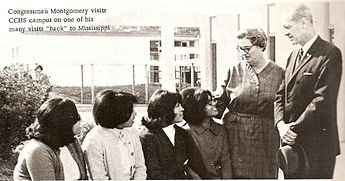- Choctaw Tribal School System
-
The Choctaw Tribal School System is a school district based in the community of Choctaw, Mississippi (USA). A non-public entity operated by the Mississippi Band of Choctaw Indians[1], the district consists of eight schools in three counties – Neshoba, Leake, and Newton – and has a total enrollment of 1,700 to 1,800 students.[2] It is the largest unified and locally-controlled Indian school system in the United States.[3] The current Director of Schools is Mr. Terry Ben.[1]
All eight schools are Title I schools with a majority of students being bilingual, speaking both Choctaw and English.[4]
Contents
Accreditation
The Choctaw Tribal School System and its schools are accredited by the Mississippi Department of Education as well as the Southern Association of Colleges and Schools.[4][5]
Eligibility
Students must belong to a recognized Native American tribe and be, at minimum, one-fourth Native American to attend the schools.[4]
Schools
- Choctaw Central High School (Grades 9-12)
- Choctaw Central Middle School (Grades 7-8)
- Bogue Chitto Elementary School (Grades PK-8)
- Conehatta Elementary School (Grades PK-8)
- Pearl River Elementary School (Grades PK-6)
- Red Water Elementary School (Grades PK-8)
- Standing Pine Elementary School (Grades PK-6)
- Tucker Elementary School (Grades PK-8)
Notable Visitations
In 1969 and later in 1971, Congressman G.V. "Sonny" Montgomery, who served in the U.S. House of Representatives 1967–1997, visited Choctaw Central High School students.
During his senior year, Marcus Dupree rushed for 1,955 yards with 26 touchdowns. On November 13 1981, Marcus Dupree's final High School game was at Choctaw Bowl at Choctaw Central High School's Warriors Stadium finishing with 5,284 rushing yards on 8.3 yards per carry; there was considerable media coverage to witness the record breaking event.[citation needed] That gave him 87 high school touchdowns to break the record set by Herschel Walker by one. Willie Morris, author, described the audience as "the most distinctive crowds I had ever seen ... four thousand or so people seemed almost an equal of mix of whites, blacks, and Indians ... After Marcus scored his touchdown, [Sid Salter] saw Cecil Price, Sr. who was ... 'jumping up and down and cheering as hard as anyone ... aint't that a kick in the pants?'" In a separate visit in 1983, Dupree came to the school for a one on one with students.
“ The stadium on the reservation was the finest I had seen all year, with excellent lights, and a large concrete grandstand on one side and bleachers on the other. A gymnasium-field house was adjacent to the grandstand with-what else?- WARRIORS in sizable letters on the facade. Although the game was more than an hour away, it was obvious there would be a big crowd. ” —Willie Morris[6]
In 1985, Eunice Kennedy Shriver, a member of the Kennedy family and founder of the special olympics, spoke and praised the school's involvement with the "Let's Play to Grow" program.
In the mid-1990s, Billy Mills, the second Native American ever to win an Olympic gold medal, met and spoke to the school body.
In 2000, John Herrington, the first Native American NASA astronaut, visited the campus. He flew his first space mission two years later as a mission specialist aboard STS-113.
In 2008, Rodney A. Grant, an Native American actor famous for his role in the movie Dances with Wolves, visited the campus.
References
- ^ a b "Choctaw Tribal Schools". 2007-09-05. http://www.cts.bia.edu/. Retrieved 2007-09-13.
- ^ "Education". Mississippi Band of Choctaw Indians. http://www.choctaw.org/government/Education.htm. Retrieved 2007-09-13.[dead link]
- ^ "Choctaw Tribal Schools". Mississippi Band of Choctaw Indians. Archived from the original on 2007-06-10. http://web.archive.org/web/20070610003333/http://www.choctaw.org/government/tribal_schools.htm. Retrieved 2007-09-13.
- ^ a b c "Choctaw Tribal School District, Choctaw, Mississippi". Center for Civic Education. http://www.civiced.org/index.php?page=SVPDP_101. Retrieved 2007-09-13.
- ^ "SACS CASI Accredited Schools: Mississippi". Council on Accreditation and School Improvement, Southern Association of Colleges and Schools. Archived from the original on 2007-08-08. http://web.archive.org/web/20070808025853/http://www.sacscasi.org/schools/Proceedings_Accredited_SACS_CASI_MS.html. Retrieved 2007-09-13.
- ^ Morris, Willie (1999). "The courting of Marcus Dupree". http://books.google.com/books?id=W6nE9QK51vkC&pg=PA291&lpg=PA291&dq=marcus+dupree+1981+choctaw&source=bl&ots=mjcRrUMx43&sig=-Ho1zQEl3LTSbqACyYNHIUVgjdw&hl=en&ei=TS3TTJLnIcaAlAf5hcy0Dg&sa=X&oi=book_result&ct=result&resnum=1&ved=0CBcQ6AEwAA#v=onepage&q=marcus%20dupree%201981%20choctaw&f=false. Retrieved 2010-11-04.
External links
- Choctaw Tribal School System – Official site.
- Mississippi Band of Choctaw Indians – Official site.
Choctaw Federally recognized tribes Culture Culture · Freedmen · Language · Religion · Bishinik periodical · Choctaw Tribal School System · Green Corn Ceremony · Stomp danceHistory Politics and law Categories:- Choctaw
- Education in Neshoba County, Mississippi
- Education in Newton County, Mississippi
- Education in Leake County, Mississippi
- School districts in Mississippi
Wikimedia Foundation. 2010.

